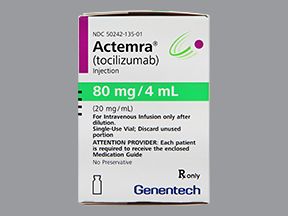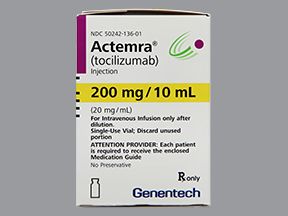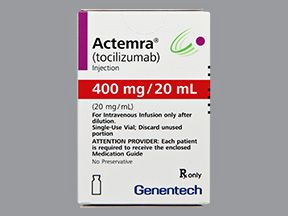IN-HOSPITAL USE FOR COVID-19Actemra (tocilizumab) has been given an emergency use authorization (EUA). This EUA allows for
in-hospital use of Actemra as a treatment for COVID-19 in certain cases. You should not take any prescription drug, including Actemra, unless your doctor recommends that you do so.For information on prevention and treatment, as well as expert tips, visit our COVID-19 hub.
Actemra (tocilizumab) is a brand-name prescription medication. The Food and Drug Administration (FDA) has approved it to treat the following conditions in certain situations:
- giant cell arteritis in adults
- rheumatoid arthritis in adults
- systemic sclerosis related to interstitial lung disease in adults
- cytokine release syndrome in adults and children ages 2 years and older
- polyarticular juvenile idiopathic arthritis in children ages 2 years and older
- systemic juvenile idiopathic arthritis in children ages 2 years and older
Actemra contains the active drug tocilizumab, which is a biologic medication. Actemra isn’t currently available in a
Actemra belongs to a group of drugs called interleukin-6 receptor antagonists. It comes as a solution that’s given as either an IV infusion or a subcutaneous injection.
For information about the dosage of Actemra, including its strengths and how to use the drug, keep reading. For a comprehensive look at Actemra, see this article.
This article describes typical dosages of Actemra provided by the drug’s manufacturer. But your doctor will prescribe the Actemra dosage that’s right for you.
Actemra comes as a solution that’s given as an IV infusion or a subcutaneous injection. For details, see the “How to use Actemra” section below.
Read on to learn about Actemra’s IV dosing and subcutaneous dosing.
Actemra forms
Actemra comes as a solution that’s available as a:
- single-use vial for IV infusion
- single-use, prefilled syringe for subcutaneous injection
- single-use, prefilled autoinjector for subcutaneous injection
The form of Actemra you’ll use depends on your age and the condition you’re using Actemra to treat.
Actemra strengths
The chart below shows the available strengths of Actemra for each form of the drug. Mg stands for milligrams and mL stands for milliliters.
| Form | Strength |
| Vial | 20 mg per mL of solution |
| Syringe | 162 mg per 0.9 mL of solution |
| Autoinjector | 162 mg per 0.9 mL of solution |
Typical dosages
Typically, your doctor will start you on the Actemra dosing schedule that’s recommended for your condition. Then they’ll monitor your condition over time to make sure that the drug is working for you. Your doctor will ultimately prescribe the dosage that provides the desired effect without increasing your risk of side effects.
The following information describes dosages that are commonly used or recommended. However, be sure to have the dose of Actemra that your doctor has prescribed for you. Your doctor will determine the best dosage to fit your needs.
Dosage for giant cell arteritis
For giant cell arteritis, Actemra is given as a subcutaneous injection. The typical Actemra injection dosage for this condition is 162 mg every 1 to 2 weeks. Your doctor will tell you how often to use this drug.
Your doctor may prescribe Actemra in combination with a corticosteroid, such as prednisone (Rayos).
Dosage for rheumatoid arthritis
For rheumatoid arthritis (RA), Actemra may be given as an IV infusion or a subcutaneous injection. For this condition, your Actemra dosage is based on your body weight in kilograms (kg). One kg is about 2.2 pounds (lb).
Your doctor may prescribe Actemra alone or in combination with other RA drugs, such as methotrexate (Trexall).
IV infusion dosing for RA
The usual IV infusion dosing of Actemra for RA is 4 mg per kg, given once every 4 weeks. For example, a person weighing 75 kg (about 165 lb) would receive 300 mg of Actemra once every 4 weeks.
If needed, your doctor may increase your dosage to 8 mg per kg once every 4 weeks.
Subcutaneous injection dosing for RA
Below is a table of the usual subcutaneous injection dosing of Actemra for RA:
| Weight | Dosage |
| Less than 100 kg (less than 220 lb) | 162 mg every 1 to 2 weeks* |
| 100 kg or more (about 220 lb or more) | 162 mg every week |
* Your doctor will instruct you on how often to use Actemra.
Dosage for systemic sclerosis related to interstitial lung disease
For systemic sclerosis related to interstitial lung disease, Actemra is given as a subcutaneous injection. The typical Actemra dosage for this condition is 162 mg every week.
Dosage for cytokine release syndrome
For cytokine release syndrome (CRS), Actemra is given as an IV infusion. You may receive only one dose of Actemra for this condition. But if your symptoms haven’t eased after the first dose, your doctor may prescribe up to 3 more doses of the drug. If so, each dose will be given at least 8 hours apart.
For CRS, your Actemra dosage is based on your body weight in kilograms (kg). One kg is about 2.2 pounds (lb). Your doctor may prescribe Actemra by itself or along with a corticosteroid, such as prednisone (Rayos).
Below is a table of the usual dosing of Actemra for CRS:
| Weight | Dose |
| Less than 30 kg (less than 66 lb) | 12 mg per kg* |
| 30 kg or more (about 66 lb or more) | 8 mg per kg** |
* For example, a person weighing 60 lb (about 27 kg) would receive 324 mg of Actemra.
** For example, a person weighing 150 lb (about 68 kg) would receive 544 mg of Actemra.
Dosage for polyarticular juvenile idiopathic arthritis
For polyarticular juvenile idiopathic arthritis (PJIA), Actemra may be given as an IV infusion or a subcutaneous injection. For this condition, your Actemra dosage is based on your body weight in kilograms (kg). One kg is about 2.2 pounds (lb).
Your doctor may prescribe Actemra by itself or along with methotrexate (Trexall).
Below is a table of the usual dosing of Actemra for PJIA:
| Weight | IV infusion dosage | Subcutaneous injection dosage |
| Less than 30 kg (less than 66 lb) | 10 mg per kg* | 162 mg every 3 weeks |
| 30 kg or more (about 66 lb or more) | 8 mg per kg** | 162 mg every 2 weeks |
* For example, a person weighing 27 kg (about 60 lb) would receive 270 mg of Actemra.
** For example, a person weighing 68 kg (about 150 lb) would receive 544 mg of Actemra.
Dosage for systemic juvenile idiopathic arthritis
For systemic juvenile idiopathic arthritis (SJIA), Actemra may be given as an IV infusion or a subcutaneous injection. For this condition, your Actemra dosage is based on your body weight in kilograms (kg). One kg is about 2.2 pounds (lb).
Your doctor may prescribe Actemra by itself or along with methotrexate (Trexall).
Below is the usual dosing of Actemra for SJIA:
| Weight | IV infusion dosage | Subcutaneous injection dosage |
| Less than 30 kg (less than 66 lb) | 12 mg per kg* | 162 mg every 2 weeks |
| 30 kg or more (about 66 lb or more) | 8 mg per kg** | 162 mg every week |
* For example, a person weighing 27 kg (about 60 lb) would receive 270 mg of Actemra.
** For example, a person weighing 68 kg (about 150 lb) would receive 544 mg of Actemra.
Children’s dosage
Actemra is approved to treat cytokine release syndrome, polyarticular juvenile idiopathic arthritis, and systemic juvenile idiopathic arthritis in children ages 2 years and older.
For these conditions, Actemra’s dosage is based on body weight. For details, see these sections above:
- “Dosage for cytokine release syndrome”
- “Dosage for polyarticular juvenile idiopathic arthritis”
- “Dosage for systemic juvenile idiopathic arthritis”
Long-term use
Whether you’ll use Actemra as a long-term treatment depends on the condition you’re using the drug to treat.
Actemra is typically a long-term treatment for all its approved uses except cytokine release syndrome (CRS). For CRS, you’ll typically have a maximum of four Actemra doses.
If you’re using Actemra for a condition other than CRS, and your doctor determines that Actemra is safe and effective for you, you’ll likely use it long term.
The Actemra dosage that your doctor prescribes will depend on several factors. These include:
- the type and severity of the condition you’re using Actemra to treat
- the form of Actemra you receive
- your weight
- your age
If you have any side effects of Actemra, this can also affect your dosage. For details, see “Dosage adjustments” below. You can also talk with your doctor or pharmacist.
Dosage adjustments
If you have renal (kidney) problems, you may wonder if your Actemra dosing needs to be adjusted. The manufacturer of Actemra hasn’t provided any dosage adjustments for this condition. If you have kidney problems, your doctor will prescribe the dosage of Actemra that’s right for you.
They may adjust your dosage if you have certain side effects of Actemra, including:
- low level of neutrophils (a type of white blood cell)
- low level of platelets (a type of red blood cell that helps your blood clot)
- high level of liver enzymes (proteins), which can be a sign of liver damage
Your doctor will give you lab tests to monitor for these side effects, and they’ll advise if your dosage needs to be adjusted.
You may develop a serious infection* while using Actemra. If so, your doctor will likely have you stop using the drug temporarily until the infection is treated.
* Actemra has a
Actemra comes as a solution that’s given as either:
- an IV infusion, which is an injection into a vein given over time, or
- a subcutaneous injection, which is an injection under the skin
Actemra infusions will be given by a healthcare professional. You’ll likely receive Actemra infusions at a clinic, hospital, infusion center, or your doctor’s office. Each infusion lasts about 1 hour.
For subcutaneous injections, you may receive your first few doses at a doctor’s office or clinic. After that, your doctor can show you how to give yourself Actemra injections at home.
To learn more about how to use Actemra, you can visit the drug manufacturer’s website for your condition:
You can also talk with your doctor or pharmacist.
If you miss an appointment to receive your Actemra infusion, call your doctor or the clinic, hospital, or infusion center right away to reschedule.
If you forget to give yourself an Actemra injection, talk with your doctor. They can describe what you should do next based on your typical dosing schedule.
To help make sure that you don’t miss a dose, try using a medication reminder. This can include setting an alarm or using a timer. You could also download a reminder app on your phone.
It’s important that you don’t use more Actemra than your doctor prescribes. For some medications, having more than the recommended amount may lead to side effects or overdose.
If you use more than the recommended amount of Actemra
Call your doctor right away if you believe you’ve used too much Actemra. Another option is to call the American Association of Poison Control Centers at 800-222-1222 or use its online tool. If you have severe symptoms, immediately call 911 or your local emergency number, or go to the nearest emergency room.
The dosages in this article are typical dosages provided by the drug’s manufacturer. If your doctor recommends Actemra for you, they will prescribe the dosage that’s right for you. Always follow the dosage that your doctor prescribes for you.
As with any drug, never change your dosage of Actemra without your doctor’s recommendation. If you have questions about the dosage of Actemra that’s right for you, talk with your doctor.
Besides learning about the dosage, you may want other information about Actemra. These additional articles might be helpful to you:
- More about Actemra. For information about other aspects of Actemra, refer to this article.
- Side effects. To learn about side effects of Actemra, see this article. You can also look at the Actemra prescribing information.
- Drug comparison. To find out how Actemra compares with other drugs, read the comparisons with Kevzara and Orencia.
- Details about arthritis. If you or your child use Actemra to treat arthritis, see our arthritis hub and list of rheumatology articles.
Disclaimer: Medical News Today has made every effort to make certain that all information is factually correct, comprehensive, and up to date. However, this article should not be used as a substitute for the knowledge and expertise of a licensed healthcare professional. You should always consult your doctor or another healthcare professional before taking any medication. The drug information contained herein is subject to change and is not intended to cover all possible uses, directions, precautions, warnings, drug interactions, allergic reactions, or adverse effects. The absence of warnings or other information for a given drug does not indicate that the drug or drug combination is safe, effective, or appropriate for all patients or all specific uses.



